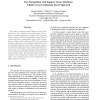Free Online Productivity Tools
i2Speak
i2Symbol
i2OCR
iTex2Img
iWeb2Print
iWeb2Shot
i2Type
iPdf2Split
iPdf2Merge
i2Bopomofo
i2Arabic
i2Style
i2Image
i2PDF
iLatex2Rtf
Sci2ools
ICCV
2001
IEEE
2001
IEEE
Face Recognition with Support Vector Machines: Global versus Component-based Approach
We present a component-based method and two global methods for face recognition and evaluate them with respect to robustness against pose changes. In the component system we first locate facial components, extract them and combine them into a single feature vector which is classified by a Support Vector Machine (SVM). The two global systems recognize faces by classifying a single feature vector consisting of the gray values of the whole face image. In the first global system we trained a single SVM classifier for each person in the database. The second system consists of sets of viewpoint-specific SVM classifiers and involves clustering during training. We performed extensive tests on a database which included faces rotated up to about ?? in depth. The component system clearly outperformed both global systems on all tests.
Computer Vision | ICCV 2001 | Single Feature Vector | Single Svm Classifier | Support Vector Machine | Systems Recognize Faces | Viewpoint-specific Svm Classifiers |
| Added | 15 Oct 2009 |
| Updated | 15 Oct 2009 |
| Type | Conference |
| Year | 2001 |
| Where | ICCV |
| Authors | Bernd Heisele, Purdy Ho, Tomaso Poggio |
Comments (0)

